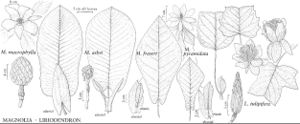Magnolia
Sp. Pl. 1: 535. 1753.
Gen. Pl. ed. 5 240. 1754.
| Taxon | Illustrator ⠉ | |
|---|---|---|
 | Magnolia macrophylla Magnolia fraseri Liriodendron tulipifera Magnolia ashei Magnolia pyramidata | John Myers John Myers John Myers John Myers John Myers |
Trees or shrubs, deciduous or evergreen. Pith homogeneous or diaphragmed. Leaves distinctly alternate or sometimes crowded in terminal whorl-like clusters; stipules early deciduous, free or adnate to and proximal on petiole. Leaf-blade: base deeply cordate or auriculate or cuneate to abruptly narrowed or rounded, margins entire, apex obtuse or acute to acuminate; surfaces abaxially chalky white or green to glaucous, pubescent or glabrous. Flowers protogynous, appearing with or before leaves; tepals 9-15, petaloid, usually spreading, creamy white, rarely greenish, yellow, or orange-yellow, outermost tepals sepaloid, sometimes strongly reflexed, greenish; stamens on elongate torus, early deciduous; filaments white or purple, very short; anthers introrse or latrorse. Follicles persistent, coalescent, forming conelike aggregate, abaxially dehiscent. Seeds with red, pink, or orange oily aril, extruded from follicles and suspended by funiculi. x=19.
Distribution
Temperate and tropical regions, Western Hemisphere, Asia (Himalayas), Asia (China), Asia (Japan), Asia (Taiwan), Asia (Malaysia), Asia (and Indonesia)
Discussion
Species ca. 120 (8 in the flora).
All species of Magnolia in the flora are cultivated. Many of the Asiatic taxa are also grown in the flora area. Numerous hybrids and cultivars from those taxa have been introduced to horticulture.
Selected References
None.
Lower Taxa
Key
| 1 | Leaf blade deeply cordate to auriculate at base. | > 2 |
| 1 | Leaf blade cuneate to abruptly narrowed or rounded at base. | > 5 |
| 2 | Leaf blade abaxially chalky white, sometimes pale green to glaucous, pubescent; foliar buds, twigs, and follicles pubescent. | > 3 |
| 2 | Leaf blade abaxially green or glaucous, glabrous; foliar buds, twigs, and follicles glabrous. | > 4 |
| 3 | Trees to 32m; flowers solitary; follicetums globose-ovoid, 5–8 × 5–7cm; leaf blade 50–110cm; stamens (300–)350–580; pistils 50–80. | Magnolia macrophylla |
| 3 | Trees to 12m; flowers solitary or often paired; follicetums cylindric to nearly ovoid, 2.5–6.5 × 1.5–4cm; leaf blade 17–56cm; stamens 170–350; pistils 20–50. | Magnolia ashei |
| 4 | Leaf blade rhombic-obovate to obovate-spatulate or oblanceolate, usually more than 25cm, gradually tapered from broadest part to base; stamens 100–200, 8–14mm; follicetums 5.5–10 × 2.5–5cm. | Magnolia fraseri |
| 4 | Leaf blade predominantly pandurate to broadly rhombic-spatulate, usually less than 25cm, abruptly tapered from broadest part to base; stamens 83–137(–150), 4.5–8(–10.5)mm; follicetums 4–6 × 2.5–3.5cm. | Magnolia pyramidata |
| 5 | Leaf blade abaxially chalky white to glaucous, glabrous or silky-pubescent, somewhat leathery. | Magnolia virginiana |
| 5 | Leaf blade abaxially green to red-brown, glabrous, felted, or pilose, thin- to thick-leathery or not leathery. | > 6 |
| 6 | Trees evergreen; leaf blade thick-leathery, abaxially glabrous or red-brown felted, adaxially lustrous green; flowers 15–30(–45)cm across, strongly lemony fragrant. | Magnolia grandiflora |
| 6 | Trees deciduous; leaf blade thin, not leathery, abaxially pale green to whitish, glabrous or pilose, adaxially green; flowers 5.5–11cm across, malodorous or aromatic. | > 7 |
| 7 | Leaves usually in terminal whorl-like clusters; leaf blade cuneate to long-tapered at base; flowers malodorous, 5.5–11cm across; tepals creamy white, 8–12cm, spreading, outermost tepals reflexed, greenish; follicetums 6–10 × 2–3.5cm; follicles long-beaked. | Magnolia tripetala |
| 7 | Leaves not in whorl-like clusters; leaf blade cuneate to truncate or rounded, slightly oblique at base; flowers aromatic, 6–9cm across; tepals greenish, glaucous, occasionally yellow to orange-yellow, usually less than 8cm, erect, outermost tepals reflexed, greenish; follicetums 2–7 × 0.8–2.7cm; follicles short-beaked. | Magnolia acuminata |
"lengthofanthers" is not declared as a valid unit of measurement for this property.